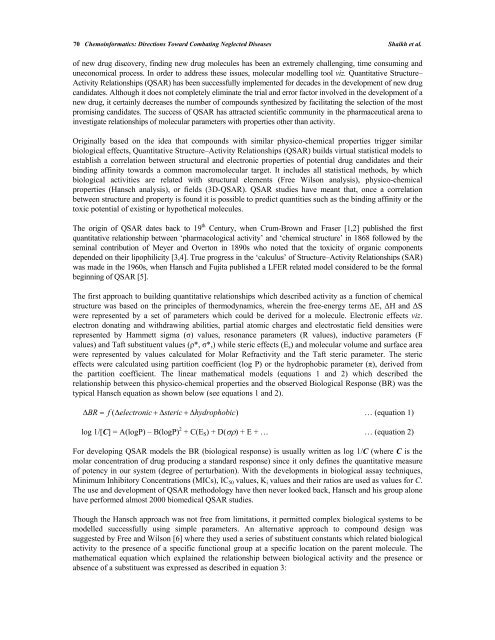chapter 1 - Bentham Science
chapter 1 - Bentham Science
chapter 1 - Bentham Science
You also want an ePaper? Increase the reach of your titles
YUMPU automatically turns print PDFs into web optimized ePapers that Google loves.
70 Chemoinformatics: Directions Toward Combating Neglected Diseases Shaikh et al.<br />
of new drug discovery, finding new drug molecules has been an extremely challenging, time consuming and<br />
uneconomical process. In order to address these issues, molecular modelling tool viz. Quantitative Structure–<br />
Activity Relationships (QSAR) has been successfully implemented for decades in the development of new drug<br />
candidates. Although it does not completely eliminate the trial and error factor involved in the development of a<br />
new drug, it certainly decreases the number of compounds synthesized by facilitating the selection of the most<br />
promising candidates. The success of QSAR has attracted scientific community in the pharmaceutical arena to<br />
investigate relationships of molecular parameters with properties other than activity.<br />
Originally based on the idea that compounds with similar physico-chemical properties trigger similar<br />
biological effects, Quantitative Structure–Activity Relationships (QSAR) builds virtual statistical models to<br />
establish a correlation between structural and electronic properties of potential drug candidates and their<br />
binding affinity towards a common macromolecular target. It includes all statistical methods, by which<br />
biological activities are related with structural elements (Free Wilson analysis), physico-chemical<br />
properties (Hansch analysis), or fields (3D-QSAR). QSAR studies have meant that, once a correlation<br />
between structure and property is found it is possible to predict quantities such as the binding affinity or the<br />
toxic potential of existing or hypothetical molecules.<br />
The origin of QSAR dates back to 19 th Century, when Crum-Brown and Fraser [1,2] published the first<br />
quantitative relationship between ‘pharmacological activity’ and ‘chemical structure’ in 1868 followed by the<br />
seminal contribution of Meyer and Overton in 1890s who noted that the toxicity of organic components<br />
depended on their lipophilicity [3,4]. True progress in the ‘calculus’ of Structure–Activity Relationships (SAR)<br />
was made in the 1960s, when Hansch and Fujita published a LFER related model considered to be the formal<br />
beginning of QSAR [5].<br />
The first approach to building quantitative relationships which described activity as a function of chemical<br />
structure was based on the principles of thermodynamics, wherein the free-energy terms ΔE, ΔH and ΔS<br />
were represented by a set of parameters which could be derived for a molecule. Electronic effects viz.<br />
electron donating and withdrawing abilities, partial atomic charges and electrostatic field densities were<br />
represented by Hammett sigma (σ) values, resonance parameters (R values), inductive parameters (F<br />
values) and Taft substituent values (ρ*, σ*,) while steric effects (Es) and molecular volume and surface area<br />
were represented by values calculated for Molar Refractivity and the Taft steric parameter. The steric<br />
effects were calculated using partition coefficient (log P) or the hydrophobic parameter (π), derived from<br />
the partition coefficient. The linear mathematical models (equations 1 and 2) which described the<br />
relationship between this physico-chemical properties and the observed Biological Response (BR) was the<br />
typical Hansch equation as shown below (see equations 1 and 2).<br />
BR f ( electronic steric hydrophobic<br />
)<br />
… (equation 1)<br />
log 1/[C] = A(logP) – B(logP) 2 + C(ES) + D() + E + … … (equation 2)<br />
For developing QSAR models the BR (biological response) is usually written as log 1/C (where C is the<br />
molar concentration of drug producing a standard response) since it only defines the quantitative measure<br />
of potency in our system (degree of perturbation). With the developments in biological assay techniques,<br />
Minimum Inhibitory Concentrations (MICs), IC50 values, Ki values and their ratios are used as values for C.<br />
The use and development of QSAR methodology have then never looked back, Hansch and his group alone<br />
have performed almost 2000 biomedical QSAR studies.<br />
Though the Hansch approach was not free from limitations, it permitted complex biological systems to be<br />
modelled successfully using simple parameters. An alternative approach to compound design was<br />
suggested by Free and Wilson [6] where they used a series of substituent constants which related biological<br />
activity to the presence of a specific functional group at a specific location on the parent molecule. The<br />
mathematical equation which explained the relationship between biological activity and the presence or<br />
absence of a substituent was expressed as described in equation 3:

















